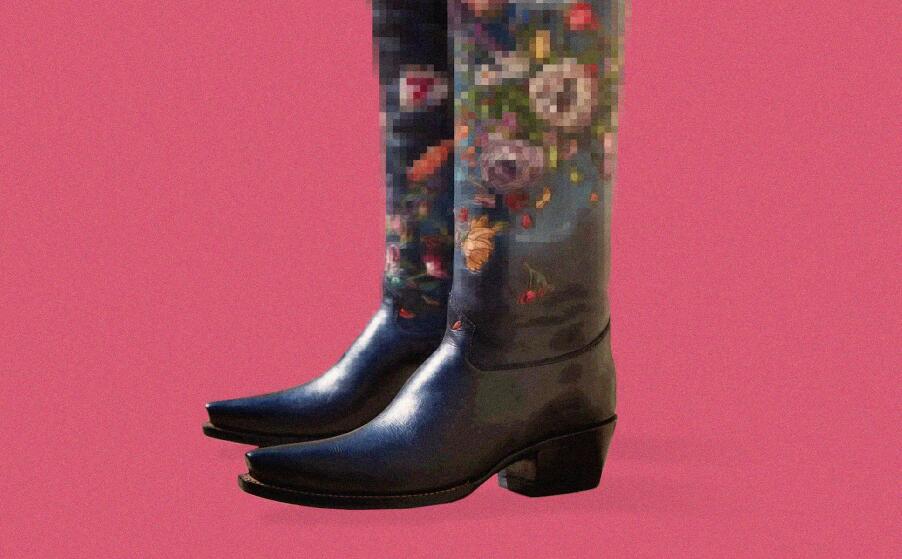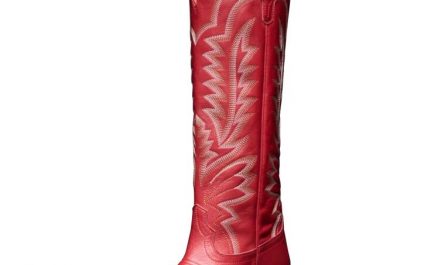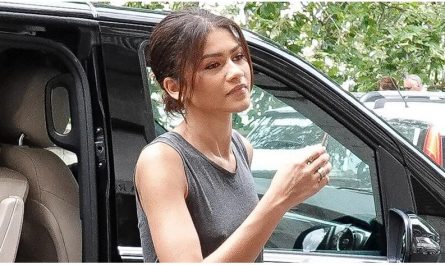Nevena Christi has been at the helm of Rocketbuster Boots in El Paso for nearly three decades. In that time, she’s put just about anything you can think of on a pair of cowboy boots: song lyrics and cattle brands, motifs inspired by Otomi embroidery and Talavera pottery, pinup girls and the Virgin Mary. Her client list is similarly varied. She’s designed custom kicks for corporate executives, rodeo queens, military veterans with prosthetic legs, and some of the biggest names in Texas, including Willie Nelson, Beyoncé, and Leon Bridges. Christi is no stranger to highly specific requests. But late last year, one order had her stumped.
A customer in London wanted all of her favorite flowers strewn from one boot to another, like they’d been scattered by the wind, and painted in the style of the Dutch masters. Christi immediately thought of the opening credits of the TV drama The Good Fight, in which everyday objects explode in slow motion. She had a vision in her head, but she couldn’t bring it to life on paper.
Then, at a New Year’s Eve party, a friend told her about a new artificial intelligence tool called ChatGPT. “He told me AI could write a poem about Rocketbuster, and I thought, ‘No way,’ ” Christi says. Within seconds of inputting details into his phone, the friend recited a full page of prose. “Too bad it can’t do images,” a shocked Christi remembers saying. At the time, ChatGPT couldn’t—but there were other programs that could.
Christi began tinkering with Midjourney, a text-to-image generator developed by Discord. Typing in terms like “black background” and “exploding vase,” Christi compiled more than twenty AI-generated images to use as references for her original drawing that would eventually be hand-carved into leather, painted, and made into a boot. Within days, AI helped Christi accomplish a task that had evaded her for months. Christi only employs the technique for unusual designs—in addition to the flower boots, another example involved a client’s favorite birds in the style of William Morris wallpaper—but she’s found other applications, too. With its ability to generate magazine-worthy spreads and even “fake” models, AI offers a major leg up in marketing for the boutique fashion brand.
Over the past year, there’s been a lot of talk about the potential threats posed by AI, and artists have raised legal questions around AI image generators, copyright, and consent. Christi understands and even empathizes with these concerns (she’s had her work copied in the past) but points out that this isn’t the first time technology has altered the design world.
Before moving to El Paso in 1997, Christi attended Parsons School of Design in Paris and spent decades in the fashion industry in New York City, creating for brands including Nicole Miller and Tiffany & Co. The garments she worked on were worn by supermodels Naomi Campbell and Christy Turlington.
“When I worked in textiles, you would have to draw the pattern, paint it in gouache [pigment], figure out how it would perfectly connect, and then repeat it,” Christi says. “A computer can now do half the stuff I used to do by hand.”
A few blocks from El Paso’s downtown in a small, stand-alone brick building, Rocketbuster’s headquarters remains charmingly old-school. Designs are kept in manila folders in filing cabinets next to Christi’s antique wooden desk, which is surrounded by her vintage cap gun collection. A try-on area with hundreds of boots backs up to industrial-style tables, covered with scissors, thread, and stacks upon stacks of leather. If you didn’t know it was 2023, you might think the scene was out of a different century.
Five days a week, anyone can wander in and watch the team of twelve work. After Christi finishes a drawing and the customer signs off, she passes it to another skilled artisan who carves the image into leather. Then the employees add color with different stains and a layer of oil for protection. Once that’s dry, they stitch and cobble together all of the pieces. Because every order varies, it’s hard to give an exact timeline, but Christi says the wait for a custom pair of boots is currently between four months, for something based on an existing style, and a year and a half, for newer, more intricate pieces.
AI is a time-saver when it comes to boot design, but Christi has also discovered a way to generate the kind of high-dollar ad campaigns that previously existed only in her imagination. She inputs prompts—different decades, colors, landscapes, even titles of sci-fi novels—into the AI image generator, and then, once she finds a picture she likes, she photographs her real boots in a similar light and superimposes them onto the fake models using Photoshop.
The first image she posted to Instagram was an androgynous duo clad in wide-brimmed hats and paisleyesque bell-bottoms to complement Rocketbuster’s animal-inspired boots. The term she’d used to get the look? “Couch upholstery.” Another campaign, for Valentine’s Day, featured an elegant woman in head-to-toe red and a knee-high boot style seemingly seated at a sidewalk cafe in Paris. The biggest success, however, was a space-age cowgirl in a pastel, Wes Anderson–esque world. The caption read: “The Optic real #customboots on Trudii our virtual AI model. Where do you think she is? Waiting at the beauty salon? Ritzy cinema? Spaceport lounge?” That post garnered nearly three thousand likes and an overwhelmingly positive response: “I don’t know where she is but I’m completely obsessed with these!!!” wrote one follower. “This photo is everything,” said another. One comment countered with a different view: “Wishing you were using a real model. This AI stuff is hogwash.”
Christi says she would love to use real models and often does photograph customers in their boots, but full-blown fashion spreads are not practical given her budget and small team. “Years ago, we did one photo shoot in El Paso with models that we had to bring in from far away. I had to provide all the clothes and we had hair and makeup [artists]. My husband was the photographer, but we still broke the bank and there was not a huge result,” she says. “It cost the equivalent of about three pairs of boots and it still didn’t look the way I wanted it to.”
If Christi were to try to replicate the same images AI delivers in the real world, she estimates a single shoot would run around $200,000. It’s a barrier to entry she says previously kept her and other boutique brands from reaching the same level as “the huge conglomerates that own many fashion houses.”
To Christi’s credit, producing these campaigns still requires skill.
“AI doesn’t know how many fingers you’re supposed to have or what position they’re supposed to be in,” she says. It also struggles with feet, eyes, and anything with words on it. Sometimes it manufactures scenes that are entirely impractical, like a man sitting on thin air. Christi spends hours correcting these flaws, and even then, if you look closely, you can spot things that feel off—proof, she says, that we’ll continue to need models and designers.
Christi supports the idea of ethical guidelines and says she would never use an image that looked like a celebrity. She even opposes the use of AI in certain areas, such as political campaigns or the military.
“I’ve seen Terminator as much as the next person,” she says. “For me, as an artist, it’s just another crayon in my box and I’m having fun with it.”


